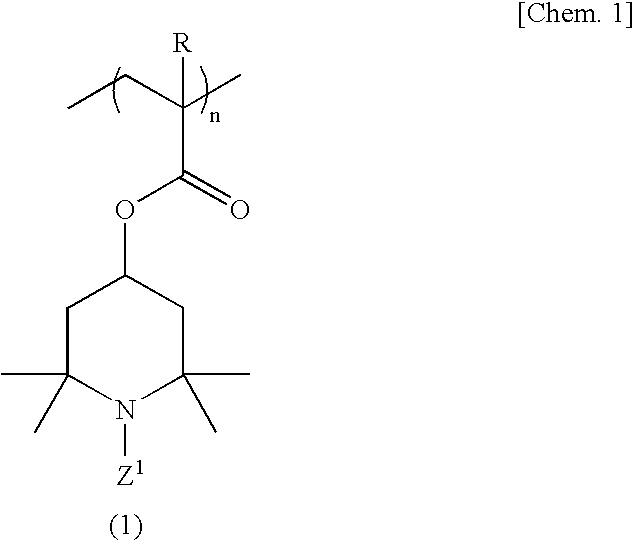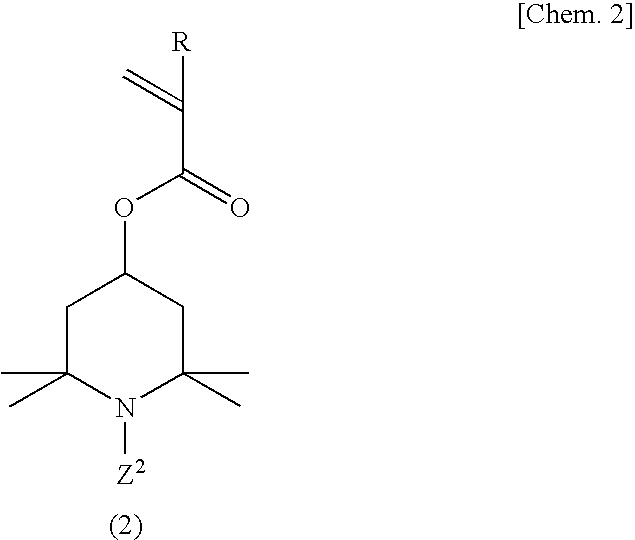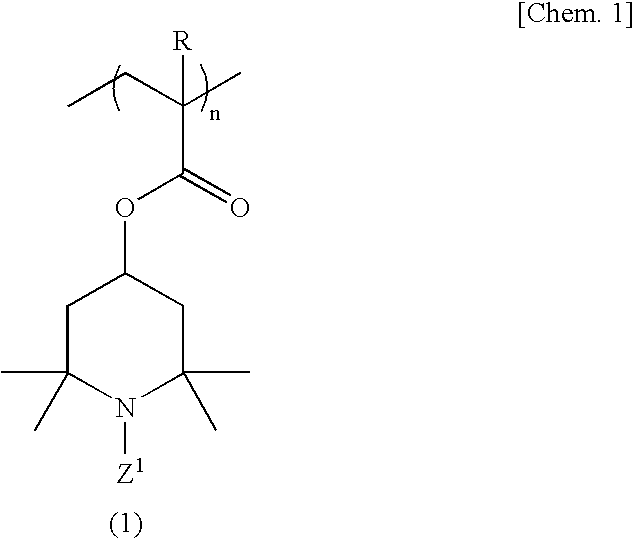Method for Producing Crosslinked Poly (Meth) Acrylate Compound
a technology of crosslinked polymer and acrylic acid, which is applied in the direction of li-accumulators, cell components, electrochemical generators, etc., can solve the problems of unsatisfactory stability of secondary battery performance, and achieve excellent stability against solvents
- Summary
- Abstract
- Description
- Claims
- Application Information
AI Technical Summary
Benefits of technology
Problems solved by technology
Method used
Image
Examples
example 1
[0099]A 500-ml four-necked flask equipped with a stirrer, nitrogen gas inlet tube, thermometer and reflux condenser was charged with 70.0 g (311 millimoles) of 2,2,6,6-tetramethyl-4-piperidinyl methacrylate, 1.23 g (6.2 millimoles) of ethylene glycol dimethacrylate and 150 ml of tetrahydrofuran, and a homogeneous solution was obtained. While this solution was maintained at 25° C., the oxygen in the reaction system was purged by passing nitrogen gas and, then, 0.358 g (2.2 millimoles) of α,α′-azobisisobutyronitrile was added as a polymerization initiator and the reaction was allowed to proceed with stirring at 50° C. for 6 hours. After completion of the reaction, the reaction mixture was cooled to room temperature and poured into 2000 ml of hexane and, then, a crosslinked polymethacrylic acid imino compound was recovered by filtration. The thus-obtained crosslinked polymethacrylic acid imino compound was washed with 500 ml of hexane and then dried under reduced pressure to give 69.5 ...
example 2
[0101]The procedure of Example 1 was followed in the same manner except that 2.50 g (12.5 millimoles) of ethylene glycol dimethacrylate was used in lieu of 1.23 g (6.2 millimoles) of ethylene glycol dimethacrylate, to give 17.2 g of a crosslinked polymethacrylic acid nitroxide compound as a red powder.
example 3
[0102]The procedure of Example 1 was followed in the same manner except that 1.40 g (6.2 millimoles) of 1,3-butanediol dimethacrylate was used in lieu of 1.23 g (6.2 millimoles) of ethylene glycol dimethacrylate, to give 17.2 g of a crosslinked polymethacrylic acid nitroxide compound as a red powder.
PUM
| Property | Measurement | Unit |
|---|---|---|
| temperature | aaaaa | aaaaa |
| temperature | aaaaa | aaaaa |
| temperature | aaaaa | aaaaa |
Abstract
Description
Claims
Application Information
 Login to View More
Login to View More - R&D
- Intellectual Property
- Life Sciences
- Materials
- Tech Scout
- Unparalleled Data Quality
- Higher Quality Content
- 60% Fewer Hallucinations
Browse by: Latest US Patents, China's latest patents, Technical Efficacy Thesaurus, Application Domain, Technology Topic, Popular Technical Reports.
© 2025 PatSnap. All rights reserved.Legal|Privacy policy|Modern Slavery Act Transparency Statement|Sitemap|About US| Contact US: help@patsnap.com



